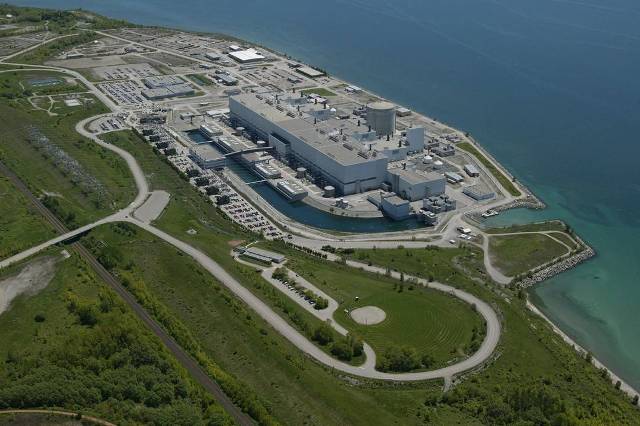
Liberals promise to cut HST from hydro bills; critics call move ‘Band-Aid solution’
by Keith Leslie, The Canadian Press

Catching flak on range of energy-related issues, Ontario Liberals say initiative will combat spiking hydro rates

The costly refurbishment of the Darlington, Ont. nuclear plant is among the long list of issues for which the opposition and interest groups have criticized the Ontario Liberals. PHOTO: Ontario Power Generation
TORONTO—Ontario consumers will get some relief from skyrocketing electricity rates under a Liberal government initiative to remove the provincial portion of the harmonized sales tax from hydro bills, which the Opposition calls a Band-Aid solution.
The Liberals announced the plan in Sept. 12’s throne speech opening the fall session of the legislature, saying Ontario’s eight-per-cent slice of the HST would be taken off hydro bills starting in January, and promising additional relief for rural ratepayers.
“It’s important to recognize that we’re doing something for our remote, rural and northern customers as well,” said Energy Minister Glenn Thibeault.
The HST reduction, which would cost taxpayers $1 billion a year, is expected to save the typical Ontario household about $130 a year, and the government projects additional savings of about $540 a year for rural electricity customers. Still, the government has provided no details on how it plans to pay for the tax break.
Just nine months ago Ontario scrapped the Clean Energy Benefit, which provided a 10-per-cent reduction on all parts of electricity bills, including the HST. That program also saved ratepayers just over $130 a year, and also cost about $1 billion annually.
The Canadian Taxpayers Federation said Premier Kathleen Wynne was basically trying to bribe Ontarians with their own money, and called it a “cynical” move.
“Our electricity bills grow at an average of eight per cent a year, so if we have a reduction of eight per cent in 2017, what’s going to happen in the next year when they don’t have an HST to cut,” asked CTF Ontario spokeswoman Christine Van Geyn.
NDP Leader Andrea Horwath said it was the Liberals who put the HST on electricity bills in the first place.
“Six years later the premier says she’ll rebate the HST, but people have to wait four more months,” said Horwath. “That raises a lot of questions about how long this rebate’s going to last and how it will work.”
The government said the is no end date for the HST cut on electricity bills. Cancelling the program in the future would require passing legislation.
Progressive Conservative Leader Patrick Brown called the tax cut “merely a Band-Aid solution.” He said Wynne ignored years of complaints about rising electricity rates and only took action after losing the Liberal stronghold of Scarborough-Rouge River to the Tories in a Sept. 1 byelection.
“When this government loses a third consecutive byelection in a riding that was a Liberal fortress held for over 20 years, now (rising electricity rates) is a crisis,” he said. “The problems of everyday Ontarians are never a problem until it’s Premier (Kathleen) Wynne’s problem.”
The Conservatives began the fall sitting on a high note with the swearing-in ceremony Monday of their newest member, byelection winner Raymond Cho. The only PC member of the legislature from Toronto took his seat for the first time after the throne speech.
Other initiatives in the speech included a plan to create an additional 100,000 licensed child care spaces for kids aged four and under over five years, starting in 2017.
“We’re setting aside between $600 to $750 million in terms of operating costs, and $1 to $3 billion in capital funds to make sure we deliver on our promise,” said Indira Naidoo-Harris, the associate minister of education.
The throne speech was triggered by Wynne’s surprise move last week to prorogue the legislature, saying the government wanted to reset its priorities halfway through its mandate—with the next election less than two years away.
Wynne, who was not available to the media Monday, had indicated the government would use the throne speech to offer some way to mitigate hydro costs for consumers.
Auditor general Bonnie Lysyk has said the electricity portion of hydro bills for homes and small businesses rose 70 per cent between 2006 and 2014.
The NDP and Tories repeated their demands Monday that the Liberals stop selling any more shares in Hydro One—Ontario’s largest electricity transmission utility—warning further privatization will put even more upward pressure on electricity rates.
The Liberals say rates increased because Ontario stopped burning coal to generate electricity and because they invested heavily in transmission grid upgrades after years of neglect. They point out it’s the energy board that sets rates, not Hydro One.
The PCs have also said electricity rates have been driven up much higher than necessary by the Liberals’ overly-generous, long-term contracts for wind and solar power, while the Green Party blames expensive refurbishments of nuclear generating stations for adding to skyrocketing hydro bills.
The throne speech also repeated the Liberals’ plan to introduce a cap-and-trade system in January, which the government predicts will add about $5 a month to home heating bills and about four-cents-a-litre to the price of gasoline.